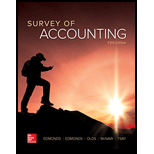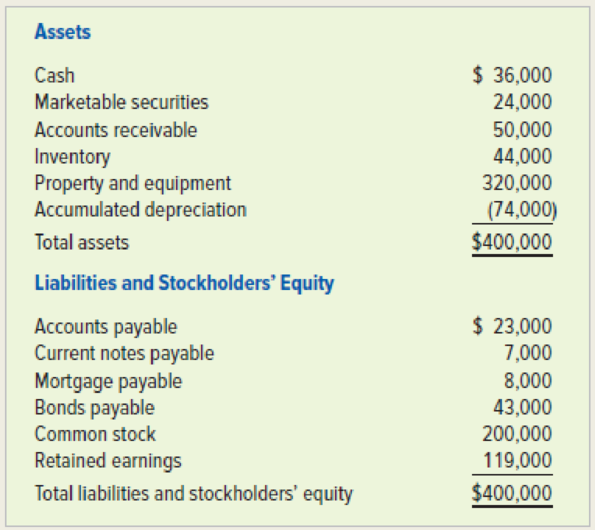
Concept explainers
Ratio analysis
Compute the specified ratios using Duluth Company’s

The average number of common stock shares outstanding during 2018 was 880 shares. Net income for
the year was $40,000.
Required
Compute each of the following and round computations to two decimal points:
a.
b. Earnings per share.
c. Quick (acid-test) ratio.
d.
e. Return on equity.
f. Debt to equity ratio.
a.
Compute the current ratio for Company D for 2018 from the data given in balance sheet.
Explanation of Solution
Current ratio: Current ratio is one of the liquidity ratios, which measures the capacity of the company to meet its short-term obligations using its current assets. Current ratio is calculated by using the formula:
Determine the current ratio of Company D:
Working Note:
Determine the current assets.
Determine the current liabilities.
Thus, the current ratio of Company D is 5.13:1.
b.
Compute the earnings per share for Company D for 2018 from the data given in balance sheet.
Explanation of Solution
Earnings per Share: Earnings per share help to measure the profitability of a company. Earnings per share are the amount of profit that is allocated to each share of outstanding stock.
Determine the earnings per share of Company D:
Thus, the earnings per share of Company D is $45.45 per share.
c.
Compute the quick (acid-test) ratio for Company D for 2018 from the data given in balance sheet.
Explanation of Solution
Quick ratio: It is a ratio used to determine a company’s ability to pay back its current liabilities by liquid assets that are current assets except inventory and prepaid expenses. Quick ratio is calculated as follows:
Determine the quick ratio of Company D:
Determine the quick assets.
Thus, the quick ratio of Company D is 3.67:1.
d.
Compute the return on investment for Company D for 2018 from the data given in balance sheet.
Explanation of Solution
Return on investments (assets): Return on investments (assets) is the financial ratio which determines the amount of net income earned by the business with the use of total assets owned by it. It indicates the magnitude of the company’s earnings with relative to its total assets. Return on investment is calculated as follows:
Determine the return on investment ratio of Company D:
Note: As there is no information given regarding Average total assets, the Total asset is assumed as Average total asset.
Thus, the return on investment of Company D is 10.00%.
e.
Compute the return on equity for Company D for 2018 from the data given in balance sheet.
Explanation of Solution
Return on equity: It is one of the profitability ratios. Return on average equity ratio is used to determine the relationship between the net income available for the common stockholders’ and the average common stock. Return on average equity is calculated as follows:
Determine the return on equity ratio of Company D:
Working Note:
Determine the amount of average total stockholders’ equity.
Note: As there is no information given regarding Average total stockholders’ equity, the Total stockholders’ equity is assumed as Average total stockholders’ equity.
Thus, the return on equity of Company D is 12.54%.
f.
Compute the debt to equity ratio for Company D for 2018 from the data given in balance sheet.
Explanation of Solution
Debt–to-equity ratio: The debt-to-equity ratio indicates that the company’s debt as a proportion of its stockholders’ equity. The debt-to-equity ratio is calculated using the formula:
Determine the debt-to-equity ratio of Company D:
Working Note:
Determine the amount of total stockholders’ equity.
Determine the amount of total liabilities.
Thus, the debt-to-equity ratio of Company D is 25.39%.
Want to see more full solutions like this?
Chapter 9 Solutions
Survey Of Accounting
- I am looking for help with this general accounting question using proper accounting standards.arrow_forwardPlease provide the correct answer to this general accounting problem using accurate calculations.arrow_forwardPlease explain the solution to this financial accounting problem with accurate explanations.arrow_forward
- Please explain the correct approach for solving this general accounting question.arrow_forwardI am searching for the correct answer to this financial accounting problem with proper accounting rules.arrow_forwardI am looking for help with this general accounting question using proper accounting standards.arrow_forward
- Please provide the solution to this financial accounting question using proper accounting principles.arrow_forwardCan you provide the valid approach to solving this financial accounting question with suitable standards?arrow_forwardPlease provide the accurate answer to this financial accounting problem using appropriate methods.arrow_forward
 Cornerstones of Financial AccountingAccountingISBN:9781337690881Author:Jay Rich, Jeff JonesPublisher:Cengage Learning
Cornerstones of Financial AccountingAccountingISBN:9781337690881Author:Jay Rich, Jeff JonesPublisher:Cengage Learning College Accounting, Chapters 1-27AccountingISBN:9781337794756Author:HEINTZ, James A.Publisher:Cengage Learning,
College Accounting, Chapters 1-27AccountingISBN:9781337794756Author:HEINTZ, James A.Publisher:Cengage Learning, Managerial AccountingAccountingISBN:9781337912020Author:Carl Warren, Ph.d. Cma William B. TaylerPublisher:South-Western College Pub
Managerial AccountingAccountingISBN:9781337912020Author:Carl Warren, Ph.d. Cma William B. TaylerPublisher:South-Western College Pub- Century 21 Accounting Multicolumn JournalAccountingISBN:9781337679503Author:GilbertsonPublisher:Cengage
 Financial AccountingAccountingISBN:9781305088436Author:Carl Warren, Jim Reeve, Jonathan DuchacPublisher:Cengage Learning
Financial AccountingAccountingISBN:9781305088436Author:Carl Warren, Jim Reeve, Jonathan DuchacPublisher:Cengage Learning Financial And Managerial AccountingAccountingISBN:9781337902663Author:WARREN, Carl S.Publisher:Cengage Learning,
Financial And Managerial AccountingAccountingISBN:9781337902663Author:WARREN, Carl S.Publisher:Cengage Learning,





